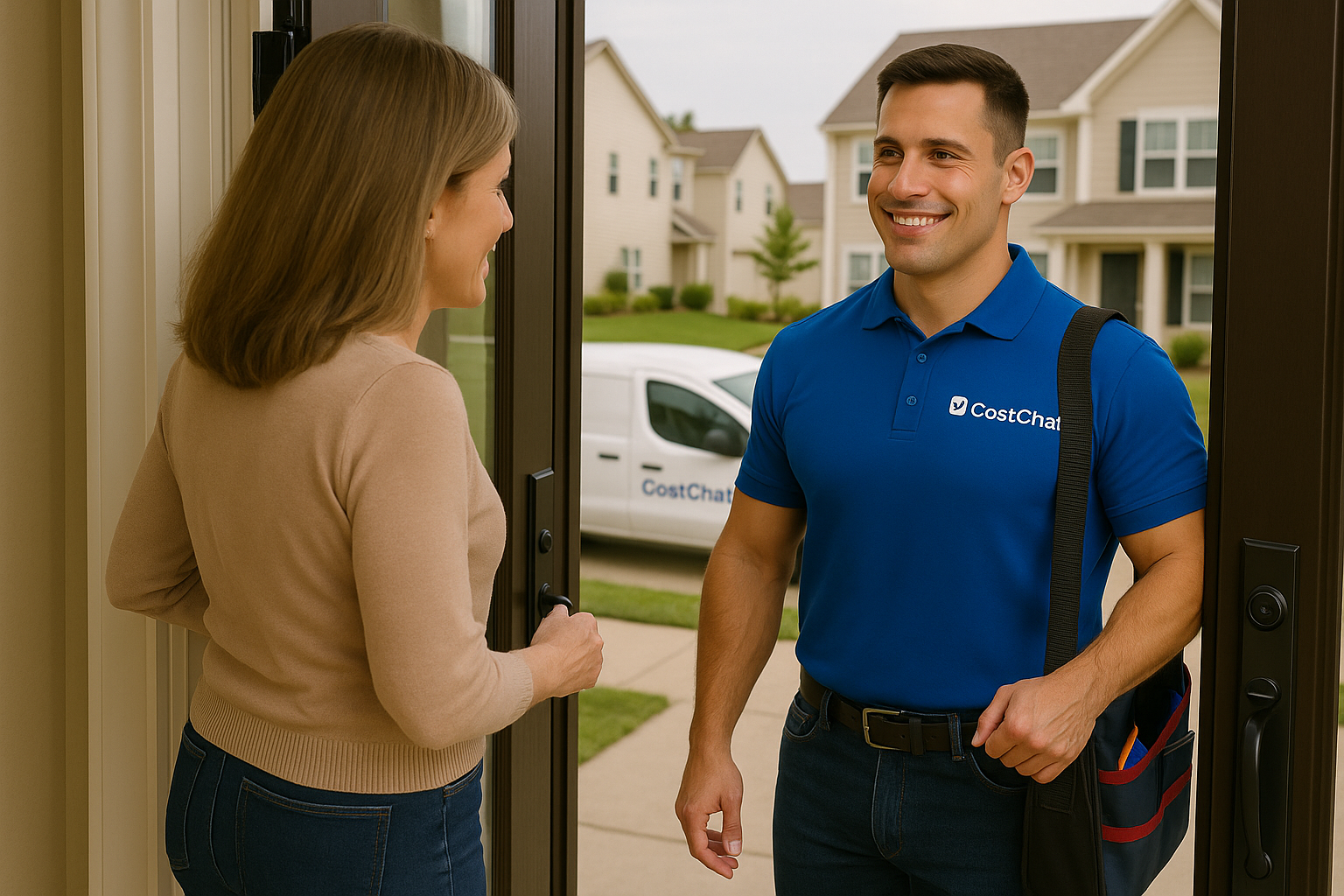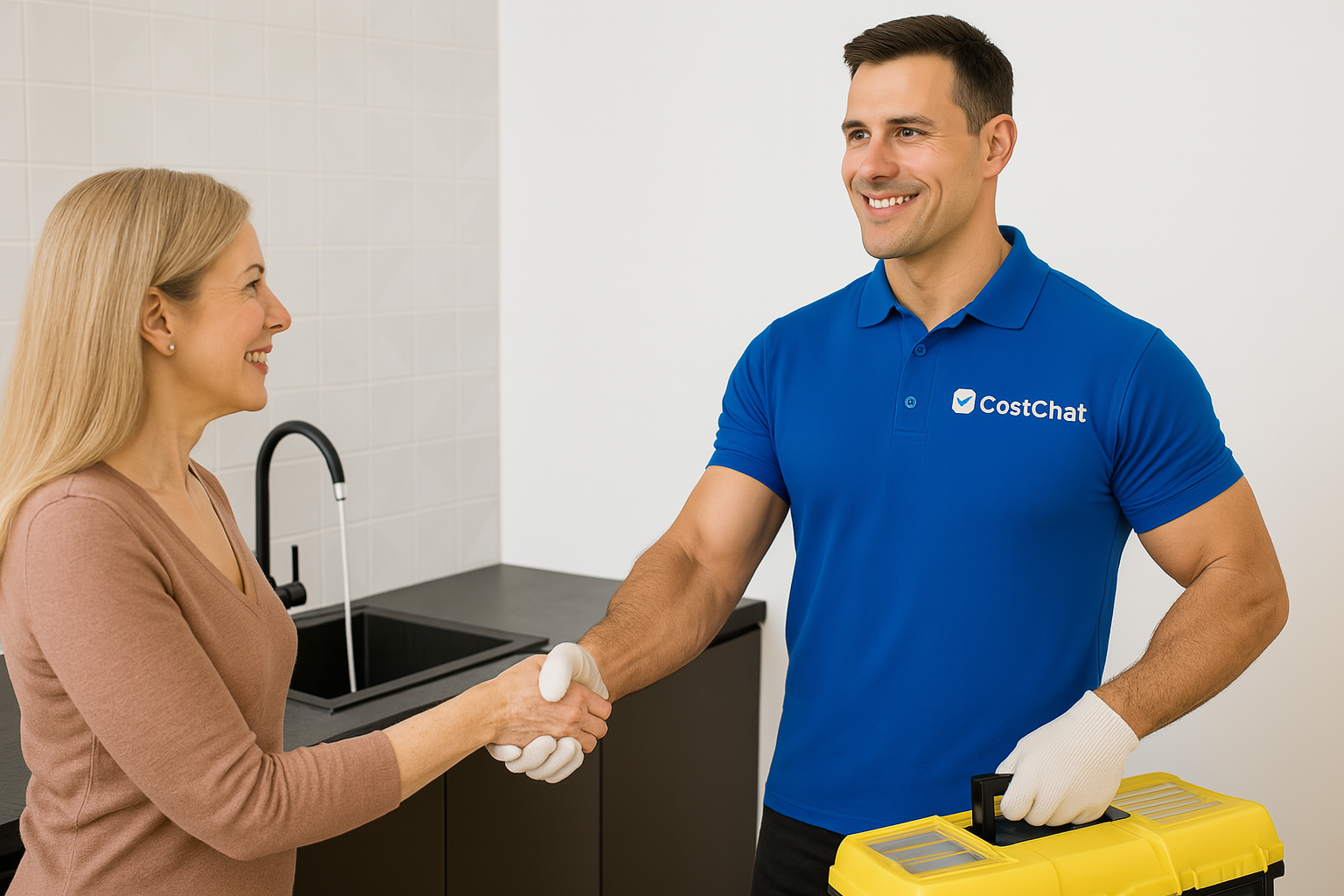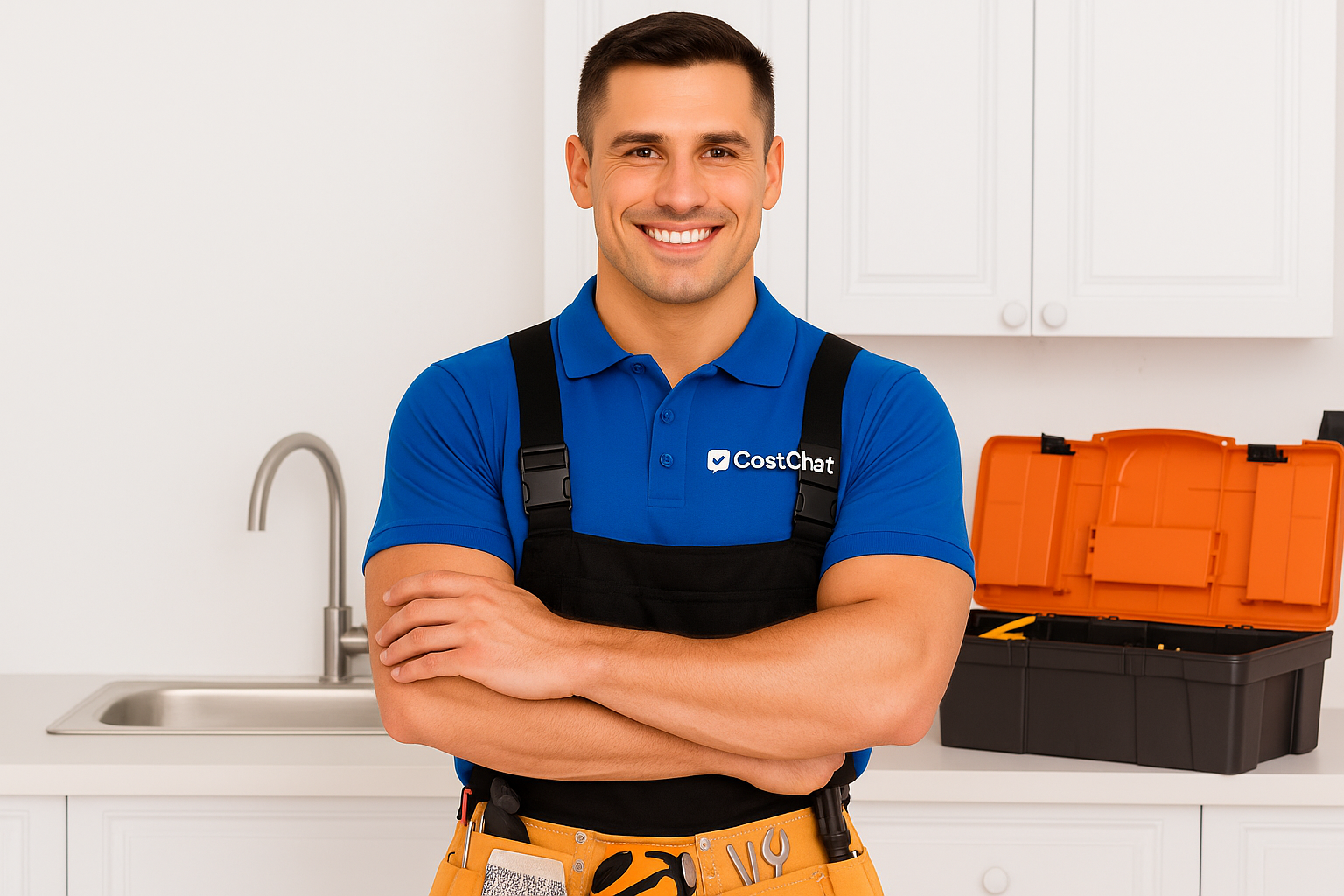
Find Verified Sewer Camera Inspection Pros Serving Omaha, NE
How to Hire Top Rated Sewer Camera Inspection Pros in Omaha, NE
Get a Free Online Estimate
Share your project details and receive a free online estimate from top-rated local pros. Not sure what it should cost? Check our Cost Guide.
Get EstimateCompare Local Quotes
View multiple free online quotes side by side. Use our Price Guide to understand labor rates, materials, and service fees before you hire.
Compare NowBook Best Top Rated Pros
Choose a licensed pro with confidence. Lock in your date after reviewing your free estimate and browsing our expert Cost Guide for peace of mind.
Book NowDid You Know?
74% ⚠️
of homeowners face surprise costs and delays — mostly from hiring unvetted pros. Don’t risk it. Hire trusted experts today.
Hire Top Rated & Verified ProsWork With Verified & Trusted Pros 🛡️
Save time, avoid costly mistakes, and experience reliable, top-quality service for every home project. Book now for priority scheduling and peace of mind.
Hire a Top Rated ProGet Instant Online Estimate of Sewer Camera Inspection in
🔎 CostChat Online Cost Estimator
Describe your project and location to get an instant estimate.
Your Comprehensive Guide to Sewer Camera Inspection in Omaha, NE
As a homeowner in Omaha, NE, you understand the importance of a well-maintained home. You invest in comfort, efficiency, and peace of mind. When it comes to the critical, yet often unseen, infrastructure beneath your property – your sewer lines – proactive care is essential. Unexpected sewer line issues can be disruptive and costly, impacting your daily life and your home's value. This guide is designed to empower you with the local knowledge needed to understand sewer camera inspections in Omaha, NE, ensuring you can make informed decisions to protect your home.
Table of Contents
- Omaha, NE's Unique Sewer Camera Inspection Landscape: Why Local Expertise Matters
- Neighborhood Hotspots: Micro-Local Sewer Camera Inspection Risks & Solutions
- Common Problems & Triggers for a Professional Sewer Camera Inspection Call
- Navigating Omaha, NE's Regulations: Permits, Code & Professional Licensing
- Maximize Your Savings: Omaha, NE Sewer Camera Inspection Rebates & Incentives
- Choosing Your Omaha, NE Sewer Camera Inspection System: Models, Sizing & Smart Features
- Cost of Sewer Camera Inspection in Omaha, NE
- Hiring Omaha, NE's Top-Rated Sewer Camera Inspection Professionals: Your Action Plan
- FAQs About Sewer Camera Inspection in Omaha, NE
Omaha, NE's Unique Sewer Camera Inspection Landscape: Why Local Expertise Matters
1.1 The Age & Character of Omaha, NE Homes: A Sewer Camera Inspection-Related Time Capsule
Omaha, with its population of approximately 480,000 residents, boasts a diverse housing stock that reflects its rich history. Many homes, particularly in established neighborhoods, were built during periods that utilized plumbing materials now considered prone to failure. Understanding the age of your Omaha home is a key indicator for potential sewer line issues.
- Early to Mid-20th Century Homes (Approx. 1900s-1960s): These homes, common in areas like Dundee, Benson, and Elmwood Park, often feature original plumbing systems. They frequently contain galvanized steel pipes, which are susceptible to internal corrosion and mineral buildup, significantly reducing water flow and increasing the risk of leaks and blockages. Many also have cast iron drain lines, which can crack, corrode, and become root-infested over time, leading to slow drains and backups.
- Mid to Late 20th Century Homes (Approx. 1970s-1990s): While many homes from this era saw the introduction of more reliable materials like copper, some may still have older infrastructure in place. Slab foundation homes built during these periods can be particularly vulnerable to slab leaks if pipes beneath the concrete foundation deteriorate.
- Newer Developments (2000s onwards): While typically equipped with modern PVC or ABS pipes, even newer homes are not immune to damage from external factors like construction, ground settling, or accidental damage during landscaping.
The mix of architectural styles, from Craftsman bungalows to ranch-style houses, often correlates with the original plumbing technologies used. Recognizing these historical contexts is crucial for anticipating potential sewer line problems that a sewer camera inspection can identify.
1.2 Omaha, NE's Environmental & Utility Factors & Climate Impact on Your Sewer Lines
Omaha's climate and environment play a significant role in the health of its underground infrastructure.
- Water Source and Quality: Omaha's water, supplied by the Metropolitan Utilities District (M.U.D.), is sourced from the Missouri and Platte Rivers and the Dakota sandstone aquifer. While M.U.D. treats the water to meet all standards, Omaha's water is moderately hard. This means it contains minerals that can contribute to scale buildup within pipes over decades, potentially narrowing passageways and increasing the risk of clogs.
- Climate and Soil Conditions: Omaha experiences a humid continental climate with distinct seasons.
- Cold Winters: The frequent freeze-thaw cycles common in Nebraska winters can cause the soil to expand and contract. This movement puts stress on underground pipes, potentially leading to cracks or joint separations, especially in older or more brittle materials.
- Rainfall and Flooding: While Omaha receives moderate rainfall, it is also susceptible to occasional flooding from the Missouri and Platte Rivers. This can saturate the soil, increasing hydrostatic pressure on sewer lines and potentially overwhelming sump pump systems that are integrated with basement drainage.
- Soil Type: Much of Omaha's soil is clay-based. Clay soil can retain moisture and shift significantly with changes in moisture content, further exacerbating pipe stress and joint movement over time.
These environmental factors create a unique set of challenges for sewer lines in Omaha, making regular inspections a wise preventative measure.

Don't wait for a sewer emergency. Get a clear view of your home's crucial underground pipes.
Request QuoteNeighborhood Hotspots: Micro-Local Sewer Camera Inspection Risks & Solutions
Different Omaha neighborhoods present unique challenges due to their age, soil composition, and development history. Understanding these local nuances can help you anticipate potential issues and know when a sewer camera inspection is particularly crucial.
- Downtown Omaha & Old Market: These historic areas often feature the oldest infrastructure, with homes and businesses sometimes relying on very old, potentially deteriorating cast iron or clay pipes. Roots from mature trees are a common issue, often leading to blockages. A sewer camera inspection is highly recommended for any property in these districts, especially before major renovations or if experiencing slow drains.
- Dundee & Benson: Known for their charming, older homes, these neighborhoods also have plumbing infrastructure that may be nearing the end of its lifespan. The presence of mature trees means root intrusion is a significant concern. Regular camera inspections can detect early signs of root damage or pipe decay before they cause a costly backup.
- West Omaha & Suburban Developments: While generally newer, some areas in West Omaha may have been built on land with specific soil conditions that can lead to shifting. Additionally, construction practices or accidental damage during landscaping can impact sewer lines. It's wise to consider an inspection if purchasing a home or if you notice any unusual drainage issues, regardless of the home's age.
Common Problems & Triggers for a Professional Sewer Camera Inspection Call
Several signs can indicate a problem with your sewer line that warrants a professional sewer camera inspection. Addressing these issues proactively can save you from significant damage and expense.
- Slow Drains or Frequent Clogs: If multiple drains in your home are draining slowly, or if you’re experiencing recurring clogs in sinks, toilets, or showers, it’s a strong indicator of a blockage or obstruction within the main sewer line. This could be due to grease buildup, debris, or root infiltration.
- Gurgling Sounds: Strange gurgling noises coming from your drains, especially after flushing a toilet or running water, often signal that wastewater is having trouble flowing freely through the sewer line, indicating a partial blockage or vent issue.
- Foul Odors: Persistent sewer smells inside or outside your home, particularly near the foundation or in the basement, can indicate a break or leak in the sewer line, allowing gases to escape.
- Sewage Backups: This is the most obvious and unpleasant sign. If sewage backs up into your home through drains or toilets, it signifies a severe blockage or collapse in the main sewer line. This is an emergency situation that requires immediate attention. You can learn more about handling plumbing emergencies here.
- Cracks or Deterioration: Over time, pipes can crack, break, or corrode, especially older materials like cast iron or galvanized steel. Tree roots seeking water are a common culprit for intrusive damage. A sewer camera inspection is the only way to visually confirm the condition of your pipes.
- Age of Plumbing: As mentioned, homes with plumbing systems over 40-50 years old are at a higher risk of failure. If your home falls into this category and you haven't had a sewer line inspection recently, it's a good preventative measure.
Recognizing these WARNING SIGNS is crucial for timely intervention. For more detailed information on identifying potential issues, please consult our Warning Signs of Plumbing Problems guide.
Navigating Omaha, NE's Regulations: Permits, Code & Professional Licensing
Ensuring your plumbing work complies with local regulations is vital for safety and property value. In Omaha, proper procedures are in place for sewer line work.
- Permitting Authority: Plumbing permits in Omaha for significant work, such as extensive sewer line repairs or replacements, are issued by the City of Omaha Planning Department. It is essential to confirm if your specific project requires a permit. You can find more information on their website: City of Omaha Planning Department.
- Governing Code: Omaha adheres to the Nebraska Plumbing Code, which is largely based on the International Plumbing Code (IPC). This code includes specific amendments tailored to Omaha's local conditions and building practices, ensuring safety and compliance.
- Required Inspections: Depending on the scope of work, the City of Omaha Planning Department may require several inspections, which could include:
- Rough-in Inspection: Performed after the new or repaired sewer lines are installed but before they are covered.
- Final Inspection: Conducted after all work is completed to ensure compliance with the plumbing code.
- DIY vs. Professional Installation: While minor DIY plumbing tasks might be permissible, significant sewer line work is complex and requires specialized knowledge and equipment. Improper installation can lead to leaks, backups, and code violations. For safety and compliance, professional installation is highly recommended. You can explore the pros and cons of DIY projects in our guide: When to Consider DIY.
- Contractor Licensing: Plumbers performing work in Omaha must be licensed. The state licensing authority is the Nebraska Department of Health and Human Services, Division of Public Health. Licensed contractors must register with the state. You can verify a plumber's license status through the official Nebraska license lookup portal. Always ensure your chosen professional is licensed and insured.
Maximize Your Savings: Omaha, NE Sewer Camera Inspection Rebates & Incentives
While direct rebates for sewer camera inspections themselves are uncommon, focusing on preventative maintenance and efficient system upgrades can lead to significant long-term savings. The Metropolitan Utilities District (M.U.D.) offers programs that indirectly support sewer line health and water conservation, which often go hand-in-hand with good plumbing practices.
- M.U.D. Water Conservation Programs: M.U.D. provides incentives for water-saving fixtures like efficient toilets and water heaters. While not directly for camera inspections, reducing overall water usage can lessen the load on your sewer lines. Their conservation programs can be found on the M.U.D. website.
- Federal Tax Credits: Certain energy-efficient home improvements may qualify for federal tax credits. While not specific to sewer lines, a holistic approach to home efficiency can yield financial benefits.
- Bonus Tip: Consider scheduling your sewer camera inspection during the off-peak seasons for plumbing services (typically late spring or early fall, outside of major holidays). You may find more availability and potentially better pricing. For more ways to save, check out our Saving Tips guide.
Choosing Your Omaha, NE Sewer Camera Inspection System: Models, Sizing & Smart Features
When considering a sewer camera inspection, the technology and approach can vary. Understanding what to look for ensures you receive the most accurate assessment of your sewer lines.
- Camera Technology: Modern sewer inspection cameras utilize high-definition video, often with powerful LED lighting to clearly illuminate pipe interiors. Some systems can also record the inspection for your review.
- Locating Capabilities: A key feature is a transmitter (or "sonde") within the camera head. This allows the technician to pinpoint the exact location and depth of any identified issues, which is crucial for planning repairs. This is particularly important in Omaha where underground utilities and varied soil conditions can make locating challenging.
- Pipe Material Considerations: The type of pipe material (e.g., PVC, cast iron, clay) will influence how the inspection is conducted and what potential issues are most likely. For instance, cast iron pipes are more prone to cracks and bellies, while PVC can be affected by root intrusion at joints.
- Smart Features: Some advanced systems offer software that can analyze pipe conditions, measure the extent of damage, and provide detailed reports.
- Key Installation Considerations (for related sewer line work):
- Pipe Diameter and Length: The size and length of your sewer line will impact the type of camera equipment needed and the time required for the inspection.
- Accessibility: The ease of access to your sewer line (e.g., via a cleanout pipe or a specific entry point) can affect the inspection process.
- Ground Conditions: Omaha's soil conditions, including clay content and potential for shifting, are important factors for technicians to consider when navigating the camera and interpreting findings.
Cost of Sewer Camera Inspection in Omaha, NE
The cost of a sewer camera inspection in Omaha, NE can vary based on several factors, but it's generally a worthwhile investment for peace of mind and preventative maintenance. As of late 2023/early 2024, homeowners can expect to pay:
- Average Cost: Between $250 to $500 for a standard residential sewer line inspection.
- Factors Influencing Cost:
- Scope of Work: A single inspection of a clearly accessible line will be less expensive than investigating persistent issues requiring multiple access points or extended camera runs.
- Complexity: Homes with challenging layouts, extensive landscaping, or the need to navigate multiple bends might incur slightly higher costs due to the increased time and expertise required.
- Professional Expertise: Highly experienced technicians with advanced equipment may charge more, but often provide more detailed and accurate assessments.
- Location within Omaha: While prices are generally consistent, some very specific or hard-to-reach areas within Omaha might see minor variations.
- Additional Services: If the inspection reveals a problem, the cost of the inspection itself is often (but not always) credited towards the repair or replacement cost.
It's always advisable to get detailed quotes from multiple reputable Omaha-based plumbing services to compare pricing and understand exactly what is included in the inspection service.
Hiring Omaha, NE's Top-Rated Sewer Camera Inspection Professionals: Your Action Plan
Choosing the right professional for your sewer camera inspection in Omaha, NE, is crucial for an accurate diagnosis and reliable service. Follow these steps to ensure you hire the best.
- Verify Licensing and Insurance: Always confirm that the plumbing company and its technicians are properly licensed by the State of Nebraska and insured. This protects you from liability in case of accidents or damage.
- Ask Hyper-Local Questions: Tailor your questions to Omaha's specific environment:
- "Are your technicians familiar with the common pipe materials used in Omaha homes built in the 1950s?"
- "How do you account for Omaha's clay soil conditions when assessing sewer line integrity?"
- "What is your process for pinpointing the exact location of a blockage or break, especially in older neighborhoods?"
- "Do you provide a recorded video of the inspection, and is that included in the standard fee?"
- Check Local Reviews: Look for reviews specifically from Omaha residents on platforms like Google, Yelp, or Angie's List. Pay attention to feedback regarding punctuality, thoroughness, and communication.
- Get Multiple Detailed Quotes: Contact at least three reputable Omaha-area plumbing services. Request itemized quotes that clearly outline what the inspection includes, the cost, and any potential additional charges if issues are found.
- Review the Contract Carefully: Ensure the service agreement includes the scope of work, the estimated timeline, the total cost, warranty information (if applicable), and a clause about cleaning up the work area.
- Mistakes to Avoid: Be aware of common pitfalls. Avoid choosing solely based on the lowest price. Ensure the professional uses advanced camera technology and has experience with Omaha's specific infrastructure challenges. For more advice, see our Mistakes to Avoid guide.
FAQs About Sewer Camera Inspection in Omaha, NE
What are the most common sewer line problems found in Omaha, NE homes?
In Omaha, NE, common sewer line problems include tree root intrusion (especially in older neighborhoods with mature trees), pipe corrosion and deterioration (particularly in cast iron or galvanized steel pipes common in homes built before the 1970s), blockages from grease and debris, and potential pipe cracks or collapses due to soil movement or aging infrastructure. Slow drains, gurgling sounds, and unpleasant odors are typical warning signs.
How long does a sewer camera inspection typically take in Omaha, NE?
A standard sewer camera inspection for a residential property in Omaha, NE, usually takes about 1 to 2 hours. This includes setting up equipment, performing the camera run, reviewing the findings, and discussing them with you. The duration can be longer if the technician needs to access multiple points or investigate extensive issues.
Is a sewer camera inspection necessary if I'm just buying a home in Omaha, NE?
Yes, it is highly recommended, especially for homes in Omaha with older plumbing systems. Purchasing a home is a significant investment, and a sewer camera inspection can reveal hidden problems like root intrusion, cracks, or collapses that might not be apparent during a standard home inspection. Identifying these issues before closing can save you from costly repairs shortly after moving in.
Can a sewer camera inspection detect slab leaks in Omaha, NE homes?
While a sewer camera inspection is primarily designed to view the inside of sewer lines exiting the home, it can sometimes provide indirect evidence of issues related to slab leaks. If the camera reveals significant damage or breaks in pipes located under a concrete slab foundation, it strongly suggests a potential slab leak. However, specialized leak detection equipment is typically used for pinpointing the exact location of a slab leak itself.
What is the significance of Omaha's moderate water hardness for my sewer lines?
Omaha's moderately hard water, containing minerals, can contribute to the gradual buildup of scale and sediment inside your sewer pipes over many years. While this is a slow process, significant buildup can eventually narrow the pipes, increasing the likelihood of clogs. A sewer camera inspection can identify areas where scale buildup is becoming problematic, allowing for potential preventative cleaning or early interv



